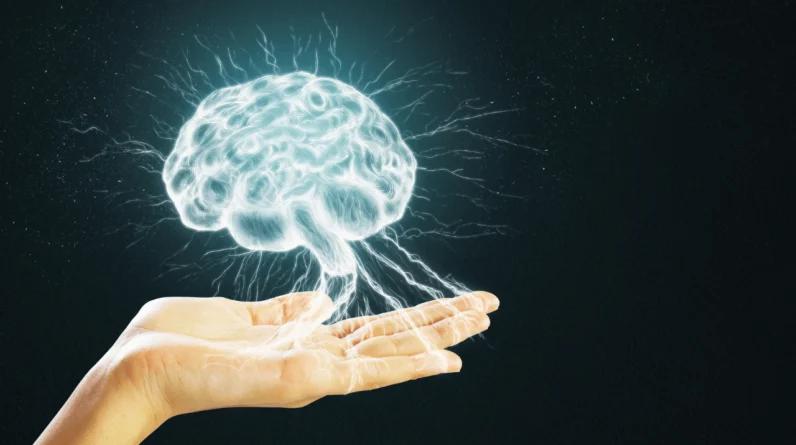
There might be affiliate links on this page, which means we get a small commission of anything you buy. As an Amazon Associate we earn from qualifying purchases. Please do your own research before making any online purchase.
Is visualization a valuable psychological technique? Or is it all pseudo-science garbage?
The truth is some of both.
There is real workable science behind the basic concept, which frames visualization as a sort of “mental rehearsal.”
But there are also a lot of books, blog posts, and faux “experts” who exaggerate claims about how you can visualize and obtain just about anything you desire.
The truth about visualization is that it is just another tool in your mental toolbox.
Similar to meditation, gratitude journaling, SMART goal-setting, KAIZEN, and many other techniques, visualization techniques can be a tool to help you reach your goals.
But visualization is not some mystical connection with the universe that will create “energy vibrations” or other esoteric results. It is just a tool to add to your planning and goal-setting.
In this blog post we will discuss some real visualization techniques that really work. We cut out the bullshit about visualization and stick to the scientific facts that have been proven in numerous studies over the years.
Aside from visualization, another planning tool in the proverbial mental toolbox that’s quite useful is the habit of mindfulness. If you want to learn more, get hold of the book Declutter Your Mind. It contains no-BS techniques for developing a deeper awareness of what’s going on in your daily life and free you from mental clutter.
When Visualization Works: Outcome Visualization
I’m sure you’ve heard of outcome visualization before. It is the most basic form of visualization. This is where you’re advised to try visualization exercises like this:
Close your eyes and imagine yourself having attained your heart’s desire, whether that’s being rich or successful, losing weight, achieving fame, or whatever.
- Now play it like a movie where you have achieved you desire.
- Or make it a play or a book where your accomplishments are well known to everyone.
- Or imagine what others would say as a eulogy about you after you have accomplished this goal.
- Or enjoy a bird’s-eye view of the moment of your success.
- Or right after your success.
This works! This is why this advice has been repeated so often, for so many years.
But it’s not like science has been asleep for the past 30 years—psychologists have been working on creating more effective visualization techniques for decades.
These “new” methods of visualization are not perfect, but they do address some holes in the effectiveness of basic “outcome visualization.”
Before we dig into some alternative (and more advanced) methods to visualize effectively, let’s see what basic outcome visualization lacks—because it is certainly not perfect.
The Problems With Outcome Visualization
One of the reasons visualization works is because you convince the mind something can be done. This is why outcome visualization can be powerful, especially for people who lack confidence. Your mind visualizes the scene of your success and sort of says, “If I can see this, I can do this.”
This can give confidence to people who are unsure of success, making this basic form of visualization a difference-maker.
But this form of visualization breaks down when people are already confident of their success.
Your brain is efficient. If a task seems easy, your subconscious anticipates that energy won’t be needed to achieve success, so it sort of “ignores” the task.
It sort of works like this: When you visualize something you “know” you can accomplish, your brain says, “This is easy. I don’t need to worry about this,” and promptly spends more time thinking up solutions for more difficult and vexing things. Like who is the masked Peacock? Or why did Ariana Grande tweet that?
The studies show that people who are confident of success before they use outcome visualization actually underperform in comparison to the control group. So it is not a good thing to use if you are already super confident.
The second problem with outcome visualization is how big of an impact it has by itself. That is to say, not much.
There is certainly a positive benefit from outcome visualization. That is a fact. When you exclude the overly confident, those who perform outcome visualization always perform better than the control group in a statistically viable way (5-10% better).
But those are not staggering numbers. 5-10%—whoop-de-doo.
They do “better,” but I wouldn’t say “far better” or “significantly better—just “slightly better.” So, improvements need to be made on how much visualization can actually improve goal performance.
In the next four sections, we will discuss the four different types of visualization, and look at their strengths and weaknesses.
Links to Related Articles & Research
1. Mental Contrasting – A Method of Visualization for the Confident
Mental contrasting is a visualization technique developed by famed NYU psychologist Gabriele Oettinge, who it just so happens is also a freakin’ German princess. Cool, huh?!
Since pure visualization produces weak gains in achieving goal success and simply does not work for a lot of people (those who are confident in success), there has to be a better way to use the power of visualization.
This is where the idea of mental contrasting comes in.
To read the full story about mental contrasting and all of the research into this visualization technique check out this post: Mental Contrasting: The Good, the Bad the Ugly. But in this post, I summarize what it is all about.
Mental contrasting is visualization on steroids. It decreases many of the risks while providing more opportunity for success.
How Does Mental Contrasting Work?
1. Visualize the success of your goals, just like you would for outcome visualization. For example, if your goal is to lose weight, the positive aspects could be improved appearance, longer life, increased energy, improved self-image, spending less on health care, etc.
2. Hone in on the topic(s) that is/are most important to you. Elaborate on and visualize the benefits and how they will make you feel emotional. Write them down to reinforce the connection with your mind.
3. Next, visualize obstacles that might keep you from success. Using our weight loss example, this could include the temptation to snack, low motivation to exercise, overeating at meals, lack of time to properly prepare healthy meals, emotional binge eating, etc.
4. Take time to focus on the obstacles, both large and small. How can you keep these obstacles from derailing you? Write them all down.
Does Mental Contrasting Work?
Studies show that mental contrasting has better results than simple outcome visualization. However, it is not perfect.
Mental contrasting is more effective than positive visualization because it connects obstacles to the desired future results. This causes the brain to realize that success will not be a “slam dunk,” and allocate the mental and physical resources needed to help you succeed in your long-term goals.
Mental contrasting is, therefore, a great tool to help people who start with a higher degree of confidence in their ability to succeed at a higher level.
However, mental contrasting suffers from the opposite problem that plagues outcome visualization. Studies have shown that people who lack confidence in their chances of success actually do worse than the control groups and the positive visualization groups.
So while mental contrasting is a better method for many, if you lack confidence in your ability to succeed, stay away from it.
Related Articles & Research
Oettingen, G., Mayer, D., Sevincer, A. T., Stephens, E. J., Pak, H. J., & Hagenah, M. (2009). Mental contrasting and goal commitment: The mediating role of energization. Personality and Social Psychology Bulletin, 35(5), 608-622.
Oettingen, G., Stephens, E. J., Mayer, D., & Brinkmann, B. (2010). Mental contrasting and the self-regulation of helping relations. Social Cognition, 28(4), 490-508.
Oettingen, G., Mayer, D., & Thorpe, J. (2010). Self-regulation of commitment to reduce cigarette consumption: Mental contrasting of future with reality. Psychology and Health, 25(8), 961-977.
Adriaanse, M. A., Oettingen, G., Gollwitzer, P. M., Hennes, E. P., de Ridder, D. T., & De Wit, J. B. (2010). When planning is not enough: Fighting unhealthy snacking habits by mental contrasting with implementation intentions (MCII). European Journal of Social Psychology, 40(7), 1277-1293.
Gollwitzer, A., Oettingen, G., Kirby, T. & Duckworth, A. L. (2011). Mental contrasting facilitates academic performance in schoolchildren. Motivation and Emotion, 35, 403-412.
Kirk, D., Oettingen, G., & Gollwitzer, P. M. (2011). Mental contrasting promotes integrative bargaining. International Journal of Conflict Management, 22(4), 324-341.
Duckworth, A. L., Grant, H., Loew, B., Oettingen, G. & Gollwitzer, P. M. (2011). Self-regulation strategies improve self-discipline in adolescents: Benefits of mental contrasting and implementation intentions. Educational Psychology: An International Journal of Experimental Educational Psychology, 31(1), 17-26.
Kappes, A., Singmann, H., & Oettingen, G. (2012). Mental contrasting instigates goal pursuit by linking obstacles of reality with instrumental behavior. Journal of Experimental Social Psychology, 48(4), 811-818.
Johannessen, K. B., Oettingen, G., & Mayer, D. (2012). Mental contrasting of a dieting wish improves self-reported health behavior. Psychology & Health, 27 (sup2), 43-58.
2. Implementation Intentions – Creating If-Then Plans for Success
The next style of visualization is my personal favorite.
Being a guy who is big on “habits,” I have used “implement intentions” many times, and find this style of visualization to be extremely effective.
Implement intentions are similar to mental contrasting. The big difference is that you take the time to come up with specific plans to overcome the obstacles.
That is what I love about this visualization technique.
Writing out concrete plans on how you will deal with the obstacles you visualize takes it out of the “let your subconscious work for you” realm and gives you some tangible work you can do to help you succeed.
Implement intentions are also one of the best-researched of any form of visualization. This is because it often works so well. Nearly 700 different experiments have been conducted into the effectiveness of using implement intentions in a wide variety of ways.
How Does Implement Intention (If-Then Planning) Work?
The key to implement intentions is in the unofficial name this style of visualization has been given: If-then planning.
You start as you would with mental contrasting.
- Visualize your goal.
- Visualize the obstacles to your goal.
Then it gets different.
You go to each obstacle (or habit trigger) and identify a way to overcome it. Like this:
When [obstacle], I will [action].
For example:
- “When I feel distracted by noise, I will move to a quiet space.”
- “When I feel like hitting the snooze button, I will immediately jump out of bed.”
- “When I feel like snacking on chips, I will have the apple I bring to work instead.”
What you are doing works on two levels. First of all, you create a workable strategy to deal with all major obstacles.
Second, you create a psychological intention to use the strategy when the obstacle presents itself.
Forming this psychological intention makes it more likely to realize that you are about to stumble over the obstacle (or habit trigger). It also makes it more likely that you will actually take the “right” action in response to your obstacle (trigger).
Want to find out more about implement intentions, specifically in regards to changing bad habits? Check out this awesome post: How an If-Then Plan Helps You Stick to a New Habit
Links to Related Articles & Research
3. Process Visualization – Visualization to Improve Specific Techniques
Process visualization is a specific technique that is used alone or in conjunction with other visualization techniques.
It is less about working on the final goal and more about practicing the process in your head. Think of it as mental rehearsal.
One of the most famous studies of process visualization came from an experiment done with people shooting free-throws in basketball.
Both the control group and the experimental group were told of the proper form to shoot free-throws. However, the experiment group was also given time and told to visualize themselves making free-throws in the “right” way.
They practiced their shots mentally, without ever touching a ball, and showed a 24% improvement in shots over the control group. Pretty significant and amazing results!
This visualization process can be used in conjunction with implement intentions, too. You simply need to visualize yourself meeting the obstacles and how you will overcome them.
For example, let’s say you visualize yourself being tempted to have that piece of cake at work, and then visualize yourself turning it down, again and again. Do enough of this mental “practice” and you may even turn down that cake without thinking about it.
4. WOOP: Wish – Outcome – Obstacle – Plan
“Woop! there it is. Woop! there it is…”
Sorry, being a young man in the early ’90s, I couldn’t resist a shout out to the classic Tag Team song.
Let’s face it—the acronym WOOP is…well….it sucks. What can I say?
But that has no bearing on its effectiveness. And it might be the most effective of all the strategies. In many ways, WOOP is the culmination of 30 years of research by psychologist Gabrielle Oettingen.
If you are interested in learning more about visualization, WOOP, and the power of positive thinking, I highly recommend you read her book: Rethinking Positive Thinking: inside the new science of motivation.
What Does the Acronym WOOP Mean?
W – WISH – This is your goal. It is important that you pick realistic goals, since WOOP breaks down if you do not believe you have a chance of succeeding.
O – OUTCOME – What do you desire from accomplishing this goal? Visualize your success in your mind.
O – OBSTACLES – What obstacles can prevent you from achieving your goal? Visualize the obstacles in your mind.
P – PLANNING – Create an if-then plan in your mind, and write it down. “If (obstacle), then I will (action).”
Does all of this seem a bit familiar? It should.
WOOP is just mental contrasting (#1) and implement intentions (#2) smashed together like peanut butter and chocolate to make something even greater.
In fact, when it is referred to in the scientific literature, WOOP is described by the even more confusing name of MCII, which stands for mental contrasting + implement intentions.
SO WOOP (or MCII) is not very original. But it is effective.
By combining mental contrasting with implement intentions you really do get a better result. In nearly every study that compared a control group vs an implement intentions group vs a WOOP group, WOOP always came out on top in terms of results, followed by implement intentions, with control being the bottom tier.
Those are some great results if you are looking for a tool to help you set and achieve goals.
It may sound silly, but the next time you think about your goals, you may not want to simply visualize success, but instead WOOP your goals!
Links to Related Articles & Research
Final Thoughts on Visualization Techniques
There is a lot of hype involved with visualization. I hear terms like manifesting, vibrations and aligning with the universe.
Does this aspect really work? Can visualization somehow allow you to achieve a mystical connection with the universe? Can it allow us to get things just by wanting them?
In a word: No.
For visualization to work, your dreams need to be realistic. Just because you can visualize fancy rainbow-colored unicorns dancing on the head of a pin does not mean that visualization can make it happen.
Similarly, if your goal takes a lot of luck and inherent skill (like becoming a movie star or pop singer), visualization is not a guarantee to make it happen. All visualization can do is help you do the right things, practice, hone your craft, and hopefully slightly improve your chances.
Again, visualization is a tool. Not magic.
In conclusion, WOOP and the other visualization techniques are not some magic pill. They are grounded in real scientific research. (Check the research tabs to learn more about the specific experiments). Your goals, therefore, need to be grounded in reality too.
But if you choose realistic goals, these practical visualization techniques can really help you increase your odds of achieving (or surpassing) your goals.
Speaking of goals, the video below provides a quick overview of SMART goals and then shows three examples for each of the seven areas of your life — for a total of 21 examples.
Having peaceful thoughts is one way of strengthening your visualization skills. To learn how, check out Declutter Your Mind. It contains techniques that reduce mental clutter so you can achieve clarity of thought all the time.







